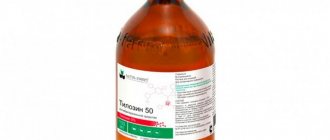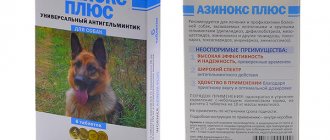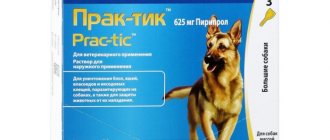Many dog owners are afraid to give them Dexafort. And for good reason: this is a serious glucocorticosteroid drug, which is prescribed according to strict indications, and if used incorrectly can cause serious disorders in the body.
In the review, I looked at how Dexafort works, when its use is necessary, in what cases it is strictly contraindicated, and what consequences it can lead to. At the end of the article you will find answers to your questions, reviews from animal owners, a list of analogues and recommendations for use.
general description
The drug suspension is based on two dexamethasone derivatives. This is a synthetic analogue of cortisol, a hormone produced by the adrenal cortex. Both substances differ in the rate of absorption and the time during which the medicine retains its healing effect on the body.
As a result, Dexafort is characterized by a high rate of absorption into the blood and the duration of the therapeutic effect. The maximum concentration of active components in the blood is achieved within 50-60 minutes, from there they spread through the bloodstream to all organs and tissues, blocking the production of substances involved in inflammatory processes. The drug remains active for up to four days, so there is no need to give injections every day.
Important! The body gets used to the hormones, and over time the drug turns out to be ineffective. You should not use Dexafort for a long time.
What is Dexafort for dogs?
A healthy body, both human and animal, produces a number of hormones that ensure the full functioning of all systems. When pathologies appear, they become insufficient, then it is necessary to use synthetic drugs. Dexafort is one of these.
This is an analogue of cortisol, a hormone produced by the adrenal glands. It stops the production of mast cells, which lead to tissue inflammation, and also synthesize substances that relieve swelling. These properties allow the body to recover from allergic reactions or autoimmune diseases.
In addition to the main functions: relieving inflammation, swelling, eliminating signs of allergies, the remedy:
- Increases the protective functions of cells.
- Reduces the body's sensitivity to external irritants.
- It is used for emergency assistance, as it has an anti-shock effect.
- Activates the liver, accelerating the process of removing toxins.
The medicine is hormonal, so it must be used as prescribed by a veterinarian.
Properties
Cortisol and its synthetic substitute have the ability to stop the process of inflammation and stimulate the synthesis of substances that help eliminate edema.
The main medicinal properties of Dexafort:
- has an antihistamine effect;
- eliminates swelling of soft tissues;
- stimulates cellular immunity;
- reduces the sensitivity of cells to irritating factors.
The last two properties contribute to the development of antitoxic and antishock effects. Taking Dexafort activates liver cells, which accelerate the metabolism of toxins and their removal from the body.
The duration of action of the hormonal drug in the body is 30-96 hours, it depends on the pathology, the general health of the dog, and the characteristics of the body.
Important! The veterinary drug should be used only as prescribed by a doctor and should not be used for self-medication.
Release form
The drug is released in hermetically sealed glass bottles of 50.0 cm³.
COMPOSITION AND RELEASE FORM The drug is a transparent, colorless or slightly yellowish liquid. 1.0 cm³ of the drug contains 0.004 g of dexamethasone phosphate, excipients and solvent up to 1.0 cm³. The drug is released in hermetically sealed glass or plastic bottles of 10.0; 20.0; 50.0 and 100.0 cm³. PHARMACOLOGICAL PROPERTIES Dexamethasone phosphate is a fluorinated analogue of hydrocortisone, more active than prednisolone and cortisone. It has a pronounced anti-inflammatory, anti-allergic, anti-edematous and gluconeogenetic effect. The drug blocks the release of inflammatory mediators by eosinophils, including prostaglandins, which are involved in the development of the inflammatory process. Stimulates steroid receptors of lymphocytes, promoting the biosynthesis of lipocortins, which have anti-edematous activity; inhibits the proliferation of lymphoid tissue and cellular immunity, and also disrupts the chemotaxis of T-lymphocytes, reducing their cytotoxic activity. The maximum concentration of dexamethasone in the blood is detected after 60 minutes. Therapeutic concentration in blood serum is maintained for 30-96 hours depending on the type of animal. Bioavailability when administered intramuscularly is 100%. Biotransformation occurs in the liver and partly in fibroblasts involved in the metabolic process. Metabolites are mainly excreted through the liver and kidneys. INDICATIONS The drug is used in animals with metabolic disorders (ketosis and toxemia after birth in ewes and sows); inflammatory processes, especially of the musculoskeletal system (arthritis, periarthritis, tendovaginitis, bursitis, dislocations, myositis, sprains); acute infectious diseases (in combination with antimicrobial agents); allergic conditions (atopic and contact dermatitis, urticaria, itching, conjunctivitis); laminitis in horses and cattle; for snake and insect bites; stressful (exhibitions, training) and shock states. DOSES AND METHOD OF ADMINISTRATION The drug is administered intramuscularly, preferably in the first half of the day: for horses and cattle – 5 cm³; pigs – 2-3 cm³; piglets, dogs – 0.5-1 cm³; cats - 0.25-0.5 cm³ once a day for three days. If necessary, the course of treatment should be continued. In case of infectious diseases, the drug is used only in combination with antimicrobial drugs. SIDE EFFECTS With long-term use, Cushing's syndrome may occur, which causes redistribution of body fat, muscle weakness, weight loss and osteoporosis. Polyuria, polydipsia and polyphagia may occur. The use of corticosteroids in lactating cows may cause a short-term decrease in milk production. In case of hidden infections, the drug may cause their exacerbation. CONTRAINDICATIONS The drug is not used during the last trimester of pregnancy, diabetes, bone fractures, viral and fungal infections. SPECIAL INSTRUCTIONS Slaughter of cattle and pigs for meat is permitted no earlier than after 48 days, horses - after 24 days. Cow's milk can be used for food after 5 days. In case of forced slaughter before the expiration of the waiting period, the meat of animals can be used to feed carnivores. Personal preventive measures When working with the drug, you should follow the rules of personal hygiene and safety precautions. Procedure for filing complaints If complications arise after using the drug, its use is stopped and the consumer contacts the State Veterinary Institution in whose territory it is located. Veterinary specialists of this institution are studying compliance with all rules for using this drug in accordance with the instructions. If a negative effect of the drug on the animal’s body is detected, veterinary specialists take samples in the required quantity for laboratory tests, write a sampling report and send it to the State Institution “Belarusian State Veterinary Center” to confirm compliance with regulatory documents. STORAGE CONDITIONS The drug is stored according to list “B” in the manufacturer’s packaging in a place protected from light at a temperature from 5ºC to 25ºC. The shelf life of the drug is 2 years from the date of manufacture, subject to storage conditions. After opening the bottle, the drug is stored for 28 days.
Purpose
The cost of the medicine is quite high - from 950 rubles for a 50 ml bottle, however, the effectiveness of Dexafort makes this indicator secondary. The drug relieves inflammatory processes in the body caused by autoimmune diseases and allergic reactions. He is appointed:
- for allergic dermatitis;
- eczema;
- bronchial asthma;
- joint pathologies - rheumatoid arthritis, arthrosis.
Dexafort is used to eliminate post-traumatic edema, during the rehabilitation period after surgery - as a prevention of inflammatory processes in the body. If the course of the disease is complicated by bacterial infections, a hormonal corticosteroid is prescribed as part of complex therapy only in combination with antibiotics.
The drug has anti-inflammatory, anti-shock effects, a calming effect and corrects metabolic processes in the dog’s body.
Analogs
Today there are many medications that can replace Dexafort, as they have the same healing properties.
Just remember that it is unacceptable to prescribe hormonal medications for your pet on your own; you should always consult a veterinarian before using such medications. Medicines with similar effects include the following drugs:
- Dexakel. It is a clear solution for injection. Mainly used for arthritis, bursitis, allergies, asthma, and metabolic disorders. According to the instructions for use of Dexakel for animals, dogs require 0.25-0.5 ml of medicine per 5 kg of body weight, cattle - 5-10 ml per 400 kg, sheep, goats, calves - 1-2 ml per 50 kg of body weight .
- Cortisone. It is used for the treatment and prevention of diseases of the gastrointestinal tract, relieves inflammatory processes well, and is suitable as an antiallergic agent. Injections are given intramuscularly or given with food. Cortisone dosage is 0.5 mg per 1 kg of pet’s weight. Apply 3 times a day every 8 hours.
- Kobaktan. Often prescribed to farm animals for the treatment of dermatitis, acute mastitis, and various infections of bacterial origin. Dosage for cattle: 2 ml per 50 kg body weight. The injection should be given once a day, for 3-5 days.
- Lisofort. It is a feed additive that promotes complete digestion of food, thereby increasing the absorption of nutrients. It is a brown powder, insoluble in liquids. The use of the drug in the diets of poultry and pigs promotes rapid growth of young animals and increased productivity of adult animals.
Application
Dexafort is sold in a veterinary pharmacy in the form of a suspension. The ready-to-use solution is injected subcutaneously into the withers or intramuscularly into the femoral muscle. Usually a single injection is prescribed in a dosage determined by the veterinarian. In case of severe disease, the doctor may prescribe a second injection after 7 days.
The choice of drug depends on the characteristics of the disease and the health status of the animal. The dosage depends on the weight of the dog, it is calculated as follows:
- for animals weighing up to 20 kg – 0.5 ml;
- for large dogs – 1 ml.
Composition and expiration date
Dexafort is available in the form of a white suspension. The active substances are dexamethasone phenylpropionate and sodium phosphate. 1 ml of solution contains 2.67 and 1.32 mg, respectively. Auxiliary components are:
- sodium chloride – 4 mg;
- sodium citrate – 11.4 mg;
- benzyl alcohol – 10.4 mg;
- methylcellulose – 4 mg;
- water for injection – up to 1 ml.
The shelf life of a closed bottle is 5 years. Once opened, the packaging is usable for 8 weeks. It must then be disposed of as household waste.
During long-term storage, separation of the solution is allowed. It must be shaken before use.
The product is stored in a place protected from light and moisture. The optimal temperature regime is +15…+20ºC. Dexafort should be out of reach of children and pets.
special instructions
Dexafort injections are painful, so when self-administering the drug, it is better to use a syringe with a thin needle (for example, an insulin one). Segregation of substances may appear in the bottle, so shake the bottle before use.
A subcutaneous injection is given as follows: carefully pulling back the skin at the withers, piercing it and slowly injecting the medicine. When administered intramuscularly, the needle should not be inserted deeper than 1.5 cm, otherwise there is a risk of hitting the bone.
The simultaneous use of Dexafort is allowed:
- with antibacterial drugs – if the course of the disease is complicated by a bacterial infection;
- with antihistamines - with pronounced signs of allergy, as an emergency aid for anaphylactic shock;
- with adrenaline - according to the indications of a medical specialist.
Important! The simultaneous use of hormonal drugs with vaccines is prohibited. Dexafort reduces the effectiveness of the vaccine by suppressing the body's immune responses.
Side effects
Based on the cost of the medicine and the regimen of use, it is not economically profitable to purchase a whole 50 ml bottle of the product. It is better to give injections in a veterinary clinic, where the doctor will monitor the dog’s condition to exclude allergic reactions to the components of the medicine and possible side effects. These include:
- increased thirst;
- increased appetite;
- frequent urination.
Negative reactions to taking Dexafort rarely occur. With an overdose and long-term use of a corticosteroid, the development of Cushing's syndrome (another name is hyperadrenocorticism) cannot be ruled out. Elevated levels of corticosteroids are manifested by:
- drowsiness;
- depressed state;
- weight loss;
- increased appetite;
- muscle weakness.
There may be areas of baldness on the dog's body, located symmetrically. If you have any of the above signs, you should contact your veterinarian.
Reviews
Owners
Valentina, 35 years old, Moscow:
“My fox terrier was in fairly good health. He has not been sick for 11 years. But one day he developed inflammation. The dog scratched them until they bled. She slept poorly and crawled on the carpet. We went to the veterinarian, who prescribed hormone therapy.
I bought Dexafort and took the injection the same day. After an hour, the pet began to itch less. A month later the disease subsided, but it was too early to rejoice. It turned out that the pathology is chronic. Periodically I inject my dog with the drug. She tolerates the treatment well. I didn’t observe any side effects.”
Alexander, 25 years old, Samara:
“Our bulldog suffered from allergic reactions since childhood. They have become especially aggravated in the last month. The dog reacted heavily to the sun's rays. She began to experience severe itching due to the floor cleaner. Each time everything was accompanied by scabies and eczema. They took various tests and put on IVs, but it didn’t help.
We went to the doctor. He recommended Dexafort. The medicine really turned out to be effective. The second injection was given a month after the first. The drug begins to act in less than an hour. The itching decreases and the animal calms down.”
Veterinarians
Konstantin, 42 years old, veterinarian, Rostov-on-Don:
“In my medical practice, I use a lot of hormonal drugs. One of the most effective is Dexafort. It acts quickly and does not cause side symptoms unless the dosage is exceeded.
The product copes well with eczema, dermatitis and parasitic diseases. They are often accompanied by unbearable itching. After the injection, scabies goes away and inflammation decreases. Sometimes a repeat course is required. The medicine is serious and should not be used without the permission of a veterinarian.”
Elena, 47 years old, veterinarian, Naberezhnye Chelny:
“Dexafort acts quickly and reliably. But it still cannot be called a completely safe product. It has many contraindications. Side effects cannot be excluded. Before use, you should carefully read the instructions and do not exceed the specified amount of the drug.
Dexafort fights well against joint diseases, mastitis, allergies and dermatitis. In special cases, I prescribe it for pregnant dogs. True, you have to reduce the dosage. Otherwise, you can harm the fetus. You can treat puppies, but it is better to consult a specialist first.”
Restrictions
Dexafort has contraindications for use and is not prescribed for the following diseases and conditions:
- viral infections;
- heart failure;
- diabetes;
- peptic ulcer;
- joint diseases - in particular osteoporosis;
- kidney pathologies and others.
For pregnant females, the medicine is prescribed only after the veterinarian has assessed the possible risk to the fetus, since Dexafort can cause intrauterine abnormalities in its development. In the later stages of pregnancy, hormonal drugs are prohibited - they can cause miscarriage and also cause premature birth.
Important! The drug has limited compatibility with other medications, so you should warn your veterinarian about their use.











